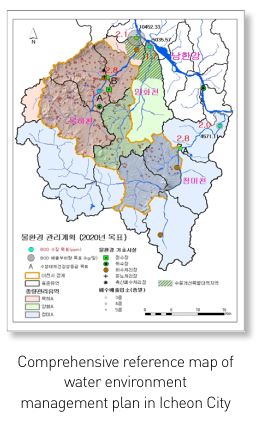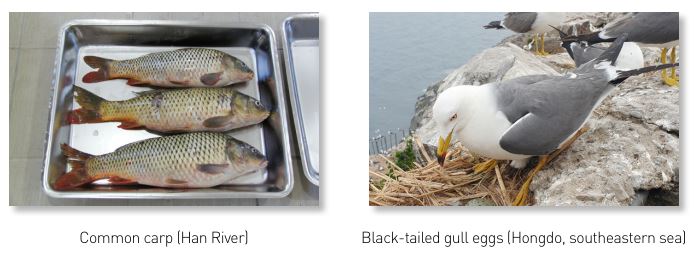Environmental Resources Research Department
- Research on life cycle assessment(LCA) of plastic waste recycling : Focusing on ELV and WEEE
To achieve circular economy and reach the goal of national carbon neutrality, we perform LCA from the generation of plastic waste from ELV(end of life vehicles) and WEEE(waste electrical and electronic equipment) to recycling. Thus, we diagnose issues in current management methods and devise improvement measures.

In 2019, 11,678,000 tons of plastic waste was generated and increased 16% from the previous year in Republic of Korea. plastic waste treated via recycling (69%), incineration (25%), and landfill (4%) and originated from industrial wastes (63%), domestic wastes (22%), and separate discharge of EPR (9%). Plastic waste from ELV and WEEE (five types of large home appliances: refrigerator, TV, air conditioner, washing machine, vending machine) were generated, respectively, 158,000 tons (1.4%) and 23,000 tons (0.2%).
We conducted an LCA from raw material to disposal of plastic waste Through a material flow analysis(MFA) using national statistical data and field survey results. Thus, we diagnosed problems that impede recycling of plastic waste from WEEE and ELV and suggest improvement measures. Also, for the safe recycling of plastic waste as resource, we investigated heavy metals(As, Cd, Cr(VI), Cu, Hg, Pb) and organics(PBDEs, DEHP, BBP, DBP, DIBP) regulated by EU’s Restriction of Hazardous Substances in electrical and electronic equipment(RoHS) and Korea’s Act on Resource Circulation of Electrical and Electronic Equipment and Vehicles.
Through improvement measures based on an LCA of plastic waste recycling, we will move one step closer to reducing waste and maximizing recycled resource utilization to achieve a circular economy and carbon neutrality.

- Research on expansion a list of waste types and discharging industries subject to hazardous characteristics(Ⅰ)
To prevent unpredicted accidents like fires and explosions caused by hazardous characteristics * of waste, we are conducting research on expansion a list of the waste types subject to the diagnosis of hazardous characteristics and the industries that discharge them. For this purpose, we have created an annual research plan for five years and are promoting the diagnosis of hazardous characteristics. In the first year, we investigated whether hazardous characteristics were expressed in three waste types, namely synthetic polymer compounds, industrial waste sludge, and wastewater treatment sludge. According to the results, harmful characteristics were expressed in ten cases: three for leaching toxicity, two for flammability, two for oxidative, and three for corrosivity.

Thus, we have created a classification list (draft) containing discharging industries and wastes expressing hazardous characteristics and the list would be used as a reference data to amend the related laws and notices.

- Research on the characteristics of microplastics generated during waste treatment process : Focusing on the investigation of analysis techniques for monitoring(Ⅰ)
With rising concerns worldwide about the environmental hazards of microplastics and their effects on human health, continuous research and management of microplastics are necessary. Accordingly, this study investigated the characteristics of microplastics in waste treatment facilities, a source of microplastics in onshore systems, to devise management measures for microplastics in waste. From the results, 8~104MPs/0.1g waste of waste plastic incineration ash, 6~190MPs/0.5g waste of water and sewage treatment sludge, and 50~206MPs/0.5g waste of landfill waste were detected, thus confirming the potential for microplastics to occur in waste. Further, according to a characteristics analysis of the detected microplastics, high percentages of polypropylene, polyethylene (PE), and terephthalate (PET) were detected. Moreover linear, fragmented, and splintered microplastics were identified in the range of 500 ㎛ or less. Based on these research findings, we created the “Analysis Methods for Microplastics in Waste (Draft),” which includes sample collection, pre-treatment, and analysis methods to serve as a reference for analyzing microplastics in waste. We also sought to provide basic data to reinforce the management of the entire domestic microplastics process by establishing a research promotion plan based on the main promotion content, including analysis techniques (technologies) to analyze microplastics in waste, microplastic monitoring for each waste treatment facility (complete enumeration), and microplastic management systems.

- Research on reducing final disposal waste amount through waste flow analysis : Improvement methods for medical waste classification system and sterilization facility standards
The generation of medical waste is continuously increasing due to the development of medical services and population aging, and the throughput of dedicated incinerators is approaching its maximum. This study prepared an improvement plan (draft) for the medical waste classification system and reported it to the Ministry of Environment. We expect this to contribute to medical waste reduction policies. Based on the data used in this study, a sourcebook was published and distributed. We also verified the safety and sterilization effects of chemical sterilization and pulverization facilities, which are not yet permitted in South Korea. To investigate the safety of chemical sterilization and pulverization facilities, we examined continuous grinding ability, moisture content of treatment residues, risks of chemical treatment agents, and whether wastewater is treated. Further, to inspect sterilization, we performed inspections according to treatment capacity, time, and temperature for six WHO Phase III indicator microorganisms*. Through this, we derived the necessary standards (draft) for installing chemical sterilization and pulverization facilities.

- Research on establishing detailed inspection methods for waste treatment facilities
We conducted a study to establish detailed inspection methods to enable more scientific and transparent installations and regular inspections of waste treatment facilities. Waste treatment facilities are divided into six fields, including incineration and landfill; we performed field surveys of 18 waste treatment facilities to devise the inspection methods (draft). To ensure the reliability of the inspection methods (draft), we held three advisory meetings with experts and inspection agency representatives of each field and performed field applicability assessments of 12 facilities. Based on the research results, we improved the inspection methods so that waste treatment facilities are inspected according to strategic standards (e.g., temperature and retention time calculation range) and include measures to secure objective data (e.g., thermal imaging cameras, image information processing devices, and TMS data utilization). We also developed detailed inspection methods (draft) that improve 31 inspection methods, such as converting indirect inspection approaches (e.g., visual inspection and simple document confirmation) to direct approaches (e.g., field measurements).

- Research on implementation measures for a waste-to-energy incentive system
With the 2019 amendment of the Renewable Energy Act and reduction in weight of the supply certificate for energy produced from non-renewable waste* to 0.25, concerns arose about the loss of competitiveness of energy production facilities such as gas, electricity, and heat sources using waste resources. Therefore, to establish an economic support system to stimulate and promote waste-to-energy facilities, we surveyed statistical data on energy production and usage of incineration heat energy recovery, solid fuel, liquid fuel, and gaseous fuel. We calculated the Waste-to-Energy Certificate weight in line with energy recovery efficiency and environmental and economic indicators and devised an incentive system (draft). Moreover, we sought to provide legal standing for the operation, management, and support system of waste-to-energy facilities by enacting the “(Tentative name) Act on the Promotion of Waste-toEnergy Promotion (Draft)” for vitalizing waste-to-energy facilities.

- Support for sustainable, eco -friendly development and improving the environmental value of national land
To improve the effectiveness of the EIA system, we opened the Environmental Impact Assessment Center (December 10, 2021) and promoted a comprehensive EIA review, management of the EIA information support system, and climate EIA response research. We devised guidelines for creating and reviewing EIA reports with supplemented field measurement and impact prediction methods for water quality (surface water) and reinforced the standardization and verification role of EIA by proposing revisions to the Regulations on the Preparation of Environmental Impact Assessment Reports, etc. (notice of the Ministry of Environment). We devised a guide (draft) for creating environmental maps in the water environment field to support the integrated management of national land-environment plans, created a summer surface temperature map by si and gun nationwide over the past five years (2016~2020), and proposed its inclusion in the Environmental Conservation Value Assessment Map(https://ecvam.neins.go.kr). Furthermore, through a 2019–2021 mobile big data analysis (30 city parks and forests nationwide) and survey (1,000 participants nationwide), we analyzed changes in urban green space usage behavior before and after the outbreak of COVID-19.

- Research on environmental quality assessment using cryopreserved biological samples
As part of the “Development of long-term diagnostic indicators for environmental changes and mid- to long-term study on receptor effects,” the Environmental Specimen Bank(ESB) obtained freshwater ecosystem carp and coastal ecosystem black-tailed gull eggs and performed a pollutant analysis. The carp were collected from the Han River Estuary and Yeongsan Estuary (2012, 2014, 2015, and 2018), and five organic pollutants (e.g., PAHs, PCBs, and OCPs) and 38 metals were analyzed in muscle specimens. According to a correlation analysis of pollutant concentrations by carp length, eight items, including mercury, exhibited high accumulation properties. Regarding the black-tailed gull eggs collected from coastal ecosystems (Western sea-Baengnyeongdo, Southeastern sea-Hongdo, Donghae-Ulleungdo) from 2012–2020, we analyzed nitrogen stable isotope ratio and total mercury to correct for the influence of differences in food chain characteristics between breeding sites on the accumulation of mercury concentration and analyzed the results. For Baengnyeongdo and Ulleungdo, the correction caused an overall increase in mercury concentration, and for Hongdo, southeastern sea, an overall decrease. In the future, we plan to collect and analyze the live food of black-tailed gulls (e.g., fish), zooplankton, and phytoplankton.

- Research on the foundation of an integrated environmental management system for facilities that pollute the environment
To facilitate the application of Best Available Techniques (BAT), technically and economically feasible environmental management techniques that can effectively reduce pollutant emissions and the like, in work sites, we have been publishing (enacting and amending) BREFs in 19 industries subject to integrated management since 2016. The BREF contains the general conditions of the specific industry, main processes, pollution emission levels by process, and BAT. It also contains the Best Available Techniques Associate Emission Level (BAT-AEL) used in setting the maximum emission standard and the emission impact analysis within the range of possible pollutant emission levels during normal operation when applying BAT in emission facilities. The final BREF is published and distributed after a domestic and overseas status survey of the industry, drafting a BREF, review by the technical working group, and deliberation by the Central Environmental Policy Committee. In 2021, we published a BREF for industrial boilers and proposed consistent, integrated permit standards for boilers commonly operated by industries. We are also working on revising new BREFs for the waste treatment and cement manufacturing industries and amending the published BREFs.

|